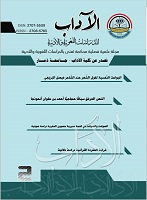Words of the Quranic proverb in Quranic readings “A semantic approach in the light of models from the Quranic readings”
DOI:
https://doi.org/10.53286/arts.v1i2.242Keywords:
Proverb, readings, semanticAbstract
Quranic Trope refers here to any object of comparison used to signify something important, a strange event, a parable, or to explain the meaning of something hitherto unknown to Arabs by dint of analogy (compare and/or contrast) with something else known to them. Therefore, this research is meant to reveal the aesthetic values, expressive features, and diversity of usage of language tools as deployed in the Quranic text. It was put into analysis according to modern and traditional linguistic data in order to reveal the characteristics of the Quranic mode of expression. This is an attempt to achieve an integrated understanding of the Quranic text and interpretation, and show the stylistic and linguistic features inherent in the Quranic context. The research also deals with Quranic trope with reference to modifications of significance based on vowel (diacritics) or number changes as observed in the various ways of recitation of the Quranic text. The words and tropes being discussed here have been classified into two sections: 1) significance of nouns in the various recitations of Quran; and 2) significance of verbs in the various recitations of Quran. Each section presents various aspects based on the difference of these words and tropes reveal in the context of the various recitations of Quran.Downloads
Downloads
Published
How to Cite
Issue
Section
License
Copyright (c) 2021 علي حفظ الله محمد ناصر

This work is licensed under a Creative Commons Attribution 4.0 International License.
Copyright and Licensing
copyright is retained by the authors. Articles are licensed under an open access Creative Commons CC BY 4.0 license, meaning that anyone may download and read the paper for free. In addition, the article may be reused and quoted provided that the original published version is cited. These conditions allow for maximum use and exposure of the work.



